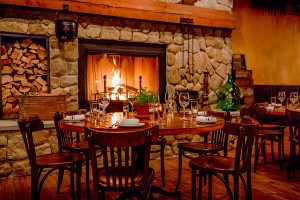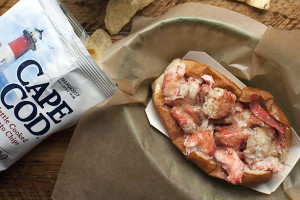The Big Deals
So there you are, a Brahmin in the mid-19th century, and you’ve got a problem: In spite of all Dad’s tirades about ostentation and frivolous spending, you’ve somehow developed a soft spot for cassia, that rare and deep-flavored spice those blasted Forbes boys keep bringing back from their voyages to China. You desperately want to quit the habit, but the flavoring’s aromatic effects on your morning porridge have you emptying your wallet again and again. And every time you do, you tell yourself this: Some foods are just worth the sacrifice — of money, of course, but also of that whole Yankee frugality thing Father keeps going on about. What you have no way of knowing is that a century and a half later, this argument will continue to live at the center of your descendants’ hearts, minds, and stomachs.
Now, as much as in the 1840s, we worship the concept of value — of paying not a penny more than what something is worth. Admittedly, that’s an elusive and subjective notion — one that extends beyond food and into every area of our lives. Then again, food just may be the only thing we care about enough (with the possible exception of sports) to throw caution to the wind. But the question of which foods are worth our money is a lot more complicated now than it was for our ancestors.
Back in the day, they didn’t have nearly the number of incredible restaurants or the bountiful selection of retail foods (local and otherwise) that we do now. Which means our temptation to spend has skyrocketed — whether on a world-class $250 prix fixe that changes our life, or a fantastic $7 burrito that makes our day a little better.
So yes, times have certainly changed. But in the frugality realm? Not so much. Our good old Yankee thrift still lingers — a constant dread that if we pay even a few dollars too much for something, we’ll have been taken for chumps.
But what we’re concerning ourselves with here is value — not parsimony. “Cheap eats” — that Ross-and-Rachel throwback concept — too often amounts to how to spend as little as possible. McDonald’s may be a bargain, but few of us see it as a temple of value; around here we don’t eat crappy, inexpensive food to survive. We want food that at the end of the day thrills us. Jolts us alive. Makes us happy. And we’ll pay for it.
So if the value of that happiness is highly subjective, as all happiness ultimately is, how do you determine what’s real value to you? How much would Proust have paid for his madeleines? How much of your Brahmin sensibility would you have sacrificed for the cassia that made your breakfast worth getting out of bed for?
Before answering, consider that getting your money’s worth is as much about the dining experience, which is to say the emotional experience, as it is about the food itself. Maybe it’s the buzz of scoring the best table in the house, or the thrill of being cared for by five servers, that makes for money well spent. It could simply be the familiar vibe of a neighborhood bistro that’s worth paying for over and over. Or maybe it’s just the way a certain atmosphere brings out the best in a particular cluster of family or friends. Sometimes we’re spending our money just to be introduced to something we’ve never tasted before. (Pass the morel, amaretto gel, and black-truffle soup, could you?)
Talking to Dante de Magistris about all of this, he mentions a curious phenomenon he’s observed as the chef-owner of two very different eateries — fine-dining Cambridge restaurant Dante, and the casual Belmont spot Il Casale. “Our sfizi [mini appetizers] at Dante are $5 each,” he says. “At Il Casale they’re $6. But because Dante is thought of as expensive or upscale, you hear people complain that the sfizi are too expensive, but at Il Casale they don’t. It’s all about perception — and the way you feel when you walk in the door.”
Ken Oringer, who owns casual restaurants (Toro, Coppa, and La Verdad) as well as tony fine-dining spots (Clio and KO Prime), has noticed a related concept. At Toro and La Verdad, both of which have partylike atmospheres, the spending proposition is far less per check than at Clio or Oringer’s upscale steakhouse, KO Prime — but they’re constantly packed, and diners wind up spending plenty because they visit again and again. “A lot of people say Bostonians don’t like to spend money in restaurants,” he says. “I don’t think that’s true. People have no problem spending for things they think are quality, and that they love.”
The question that ultimately determines value, then, isn’t, “What is this certain food worth?” But rather, “What is it worth to me?” There are modern-day, cassialike splurges all around us. To find them, we sent our writers — everyone from longtime food editors to political junkies who prefer to eat nothing fancy — across town on personal quests to find the foodstuffs for which they’ll gladly open their wallets.
Dig in.
Suckling Pig :: Troquet, $39
Don’t take this the wrong way, but there are a lot of pigs in this city. Some come wholly dressed; others in the form of pork chops. And then, for the brave, there are the big, fat, meaty heads. My pig — the version that allows me to indulge in the whole animal without paying $50 per plate (an average around town) — is the roast suckling specimen found at Troquet. The dish features a hunk of thigh or shoulder, which chef Scott Hebert cures, then confits, and finally pan-roasts à la minute to create a crackling, caramelized skin. The saddle and loin are turned into porchetta, and the rillette — feet, cheeks, and neck blended with a brunoise of carrot, cornichon, and whole-grain mustard — is rendered into a pressed rectangle of flaky, gamey goodness. Nothing is wasted, not even the bones, which make a stock that’s swept across the plate — a finishing touch I’m happy to put my money into. 140 Boylston St., Boston, 617-695-9463, troquetboston.com. — Naomi Kooker
Toscanini’s :: Ice Cream, $5.50
I’ve been the victim of brain freeze at just about every ice cream shop in town. So when a craving for frozen custard strikes (which it does almost every Friday night), I forgo the half-gallon of Hood and can of Reddi-wip for two unadorned scoops from my all-time favorite spot: Toscanini’s. Why is this place a deal? Owner Gus Rancatore’s confections aren’t merely ice creams. They’re works of art. This shop’s flavor variety is unrivaled, from the famous burnt caramel and the refreshing khulfee — nuts, cardamom, and oftentimes saffron — to the mind-altering brown butter/brown sugar/brownie (a.k.a. B3), a confluence of dominating dessert forces. Then there’s the texture — thick, silky, delectably creamy. Rancatore produces them all on site, with impeccable ingredients — chocolate by Callebaut and Cacao Barry, leaves of fresh mint and tarragon grown in Dartmouth by Eva’s Garden, and locally sourced honey. He even whips his own cream to boot. Add it all up, and I’m happy to part with $5 and change. One scoop, $4.25; two scoops, $5.50; 899 Main St., Cambridge, 617-491-5877, tosci.com. — Brittany Jasnoff
Arirang House :: Korean Lunch Buffet, $9
A buffet, if it does its job, leaves you disgusted: disgusted with how much you ate, disgusted with how you now feel. But at the Back Bay’s Arirang House, I manage to eat like a glutton without feeling like one. The steamed broccoli, the seaweed salad — options I don’t see at my other buffet haunts — complement the heavier choices, such as the grilled meats. You leave the place with the air of a well-fed, moderately healthy person. Who just got an incredible deal. 162 Massachusetts Ave., Boston, 617-536-1277. — Paul Kix
Matt Murphy’s :: Dinner for Two, $30 per person
At the end of a workday, when my pregnant belly is screaming for sustenance and the family budget is busted thanks to baby gear, relief for my husband and me is found in a window-side banquette at Matt Murphy’s Pub. This fish and chippie recently got a glossy new coat of paint (noise-reducing ceiling panels in an Irish pub — really?), but the staffers haven’t lost their genial manner. Here we get what feels like a $100 dinner for just under $30 each. We can take the edge off with phyllo-bound, house-ground sausage rolls, a mini crock of the tavern’s maple-laced baked beans, and comforting shepherd’s pie. Occasionally we’ll tackle the delicate puff-pastry tartlet, which brims with wild mushrooms and tangy goat cheese. We even stretch our dollar with one of the massive desserts (two spoons, please), knowing it will be worth every penny. 14 Harvard St., Brookline, 617-232-0188, mattmurphyspub.com. — Erin Byers Murray
Bread Pudding :: Eastern Standard, $8
Gooey. Crackly. Caramelly. Bread pudding is a marvel that deserves plenty of adjectives. But at Eastern Standard, where pastry chef Jennifer Luna douses the treat in butterscotch and serves it for less than the price of an equally sweet cocktail, it deserves an entire love sonnet. Maybe it’s the salted caramel forming a generous pool on the plate, or the way the homemade praline ice cream melts over the top — whatever it is, all it takes is one bite deliciously enhanced with a crunchy Florentine cookie, and I’m smitten. 528 Commonwealth Ave., Boston, 617-532-9100, easternstandardboston.com. — B. J.








